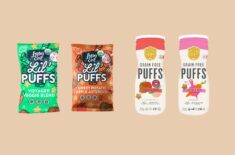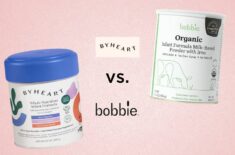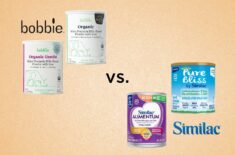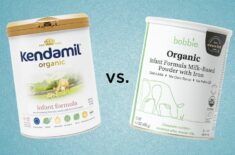Overview
Muffins are a lunchbox favorite for older kids and adults, but can you offer them to a baby who’s younger than one year old?
The answer is “yes,” mama.
Muffins can be a versatile food that’s easy to prepare for BLW (baby-led weaning). What’s great about muffins is that they aren’t just for big kids but can be a favorite food for your baby, too.
BLW pioneer Dr. Gill Rapley recommends letting your baby share family meals. So, you can prepare this finger food for everyone to share during mealtimes. (1)
Your baby just might enjoy munching on these goodies with everyone else in the family.
As a bonus, you can add vegetables and fruits to your baby muffin recipe for a healthier treat.
Are you searching for easy baby food recipes for healthy muffins? You can find one below from a famous cookbook author who also wrote a BLW book with 120 recipe ideas.
You can also learn more about the nutrients your baby can get from muffins, whether your six-month-old can eat these treats, and how to cut these foods in BLW to reduce choking risks. Are there other safety concerns to consider with muffins? Find out below.
Can Babies Have Muffins in BLW?
Yes, babies can have muffins in BLW.
Baby-led weaning is a feeding approach that encourages self-feeding with finger foods. Muffins fit the criteria for finger foods because they’re firm enough to hold but soft for babies to chew and swallow.
However, it’s a good idea to hold the added sugars and salt, especially for young babies and children under one year old.
Excessive sugar intake can cause obesity. (2)
Adding salt to babies’ food isn’t recommended. Although salt is important in the human body, babies only need less than 1g per day. Their kidneys are still developing and can’t process more than this amount. (3)
Also, we recommend whole foods such as sliced avocados, bananas, and watermelons as your baby’s first foods.
Top Reasons To Serve Homemade Muffins In BLW
Nutrition Facts
Depending on the ingredients used, a simple recipe of baby muffins can contain the following nutrients per serving (one small muffin): (4)
- Calories: 201 kcal
- Carbohydrates: 37 g
- Dietary fiber: 2 g
- Calcium: 12 mg
- Iron: 1 mg
- Potassium: 75 mg
- Vitamin A: 7 mcg
- Vitamin C: 0 mg
The vitamin C content in the basic muffin example above is 0 mg. You can choose healthy recipes with strawberries, broccoli, and citrus fruits for increased vitamin content.
In making baby muffins, iron-enriched flour and nutrient-rich gluten-free flours (such as almond flour, coconut flour, oat, or chickpea flour) can be better choices than regular all-purpose flour because they contain more nutrients. (5)(6)
Homemade muffins are also better than commercially available ones.
Although they might have similar nutritional values as homemade ones, many commercial muffins can contain plenty of added sugars, salt, additives, trans fats/ processed saturated fats, artificial flavoring, and preservatives. (7)
Other Reasons To Offer Homemade Muffins
- You can prepare muffins in a mini size that fits your baby’s small hands.
- Your baby can self-feed on this finger food.
- It can be a yummy snack for babies, kids, and adults alike.
- Many baby muffin recipes are freezer-friendly.
- You can add healthy ingredients such as fruits and/or veggies.
Food Safety With Muffins
Can Babies Choke On Muffins?
The CDC (Centers for Disease Control and Prevention) doesn’t list muffins as one of the most common choking hazards. (8)
However, the government agency warns against baked products with nut pieces, seeds, or whole-grain kernels. For reduced choking risks, try to avoid adding these items into your baby’s muffins.
Some muffin recipes might include these, but they’re likely optional.
What To Avoid In Making Your Baby’s Muffins
- Dark chocolate chips
- Dried fruits like cranberries, raisins, or chopped dates
- Nuts or seeds like chopped almonds, walnuts, pecans, sunflower seeds, etc.
- Added sugars
- Salt
Are Muffins An Allergen?
Yes, most muffin recipes use common allergens such as milk, butter, eggs, and wheat (gluten). Some also include tree nuts such as chopped walnuts, while others contain soy.
The good news, mommy, is that you can prepare allergen-free muffins by replacing these ingredients with suitable substitutes.
For dairy-free muffins, you can substitute melted butter with coconut oil and milk with dairy-free, allergen-free milk such as oat milk. Some moms opt to use breast milk or their baby’s formula.
You can choose gluten-free flour and find egg-free muffin recipes. Some moms find applesauce, bananas, and flax or chia “eggs” as good substitutes for eggs.
Food-Borne Illnesses With Muffins
Like other cooked foods, muffins can cause food-borne illnesses if they’re left at room temperature for too long (more than two hours), or several days (more than four) in the fridge. (9)
To avoid this, immediately put freshly baked muffins in the freezer. It can be a good idea to put them in single-serve airtight containers.
Frozen muffins can last for up to three months. You can thaw them for at least three hours, then reheat. However, cool before offering to your baby.
Can A Six-Month-Old Eat Muffins?
Yes, as long as they show signs of readiness to eat solid foods and you get the green light from your pediatrician.
In BLW, babies can start eating finger foods when they’re ready for solids, which is usually around six months of age.
Can A Seven-Month-Old Eat Muffins?
Yes. Be sure they’re showing signs of readiness, and your pediatrician approves giving solid foods to your baby. Cooked muffins are soft and can be offered to kids this age.
Note that babies develop at varied rates. Some might be ready by four months, while others need a couple more months.
If your healthy baby doesn’t start solid foods until they’re seven months old or more, you don’t have to worry too much.
You can also visit your pediatrician for food questions and baby development concerns.
How Do I Give My Six-Month-Old Muffins?
You can give them whole mini muffins on their food tray.
Start with simple or basic single-ingredient recipes (such as banana muffins), then gradually offer combinations (apple, carrot, and banana muffins) as they grow older.
For babies who aren’t allergic to eggs, breakfast muffins such as egg and spinach cups can be a good choice.
Be sure to seek your pediatrician’s approval before introducing eggs and other potential allergens to your baby.
Can My Baby Eat Blueberry Muffins?
You can introduce blueberry muffins when your baby is ready for solid foods.
While blueberries are considered a common choking hazard because they’re small and hard, they turn soft after baking. But if you’re still worried, you can smash them before baking. (8)
Can My Baby Eat Muffins With No Teeth?
Yes. Muffins are soft enough for your baby to chew with their gums. It also has a crumbly consistency that can easily break down in your baby’s mouth without a lot of chewing.
How Do You Prepare Muffins For Baby Led Weaning?
Make Soft Muffins
- If you want soft, fluffy muffins, don’t overmix. Simply mix until they are just combined but not too smooth.
Low-Sugar Muffins
- Avoid added sugars and salt (exclude if you see them in easy recipes). Excessive sugars can cause obesity, while added salt isn’t recommended for babies. (2)(3)
- A very ripe banana or apple can be a natural sweetener to your baby’s muffins.
- Fresh apple or pear puree can substitute for applesauce. You can also try mashed bananas or sweet potatoes.
Reduced Choking Risks
- Be sure to avoid adding seeds, nuts, and fruits in a young baby’s muffins because these can be choking hazards. (8)
Can I Use Puree For Baby Muffins?
Yes. You can also use fruit or vegetable puree for baking your baby muffins.
Other Baking Tips For BLW Muffins
- Lightly spray with oil or line your muffin tin to prevent your baked goodies from sticking.
- You can also opt for silicone muffin pans so you wouldn’t have to use muffin liners.
- You can add grated fruits and veggies to your little one’s muffins.
- If you’re using frozen blueberries, don’t thaw them. Simply add them into your batter.
- Carefully read the recipe instructions, especially the ingredient list. For example, baking soda is different from baking powder. You can substitute them for each other in any recipe.
How Do You Cut Muffins For Baby-Led Weaning?
Prepare muffins according to your child’s age to reduce choking hazards.
As a rule of thumb in preparing BLW foods, the younger the baby, the bigger the cut or slice. However, this rule doesn’t apply to all foods.
For 4-6 Months Old
Bigger cuts or slices can be easier to grasp and are less likely to swallow whole accidentally.
Mini muffins are ideal for this age because they’re just around the size of your baby’s hand.
For bigger or regular-sized muffins, half it before giving one part to your baby.
For 7-12 Months Old
As they develop their pincer grasp, they can use their thumb and index finger to pick up smaller pieces of muffins. But try to continue serving in bigger sizes to avoid choking risks.
For 12+ Months OId
Babies this age might already hold a standard-sized muffin and take a bite. Mini muffins can pose a choking risk because your baby might swallow these foods whole.
A big piece of food can get stuck in a baby’s airways, causing breathing difficulties.
How To Store Muffins
Store in an airtight container or lunchbox for up to four days in the fridge or for three months in the freezer. (9)
Thaw the day before or around three hours before eating, at room temperature.
Baby-Led Weaning Muffin Recipe To Try
Apple & Carrot Muffins With Maple Syrup
Renowned cookbook author Annabel Karmel created this recipe for toddlers and the rest of the family. She also wrote some BLW recipe books. (10)
Note: We modified this recipe to create sugar-free muffins.
- Prep time: 15 minutes
- Cook time: 25 minutes
- Total time: 40 minutes
Ingredients
- One large apple (peeled, cored, and grated)
- ⅞ cup (2.8 oz) carrots (peeled and grated)
- 1 cup (5.3 oz) plain whole wheat flour (½ cup rolled oats for gluten-free muffins)
- ½ cup (2.65 oz) self-raising flour
- 1½ tsp baking powder
- ½ tsp ground ginger
- ½ tsp ground cinnamon
- ½ cup (4 fl oz) coconut oil
- ⅖ cup (3.4 fl oz) applesauce or one ripe banana (instead of maple syrup)
- Two medium eggs, lightly beaten (substitute with chia or flax “egg” for an egg-free recipe)
- ½ tsp vanilla extract
Preparation Instructions
- Preheat oven to 350F.
- Combine the dry ingredients (flour, cinnamon, baking powder, and ground ginger) in a large bowl.
- Combine the wet ingredients (oil, maple syrup alternative, eggs or egg alternatives, and vanilla extract) in a separate mixing bowl.
- Lightly beat until blended.
- Add the grated apples and carrots to the liquid mixture. Stir well.
- Fold in the dry ingredients until just combined. Don’t over mix to prevent muffins from becoming dense.
- Line the muffin tray (standard size) with 12 paper cups. Fill until two-thirds full.
- Bake for 20-25 minutes. You can check if it’s golden brown or use a toothpick to check if they’re done.
- This easy recipe can make around 24 pieces if you’re making mini muffins. The baking time is reduced to around 15 to 20 minutes.
- Let the muffins cool for around five minutes before removing them from the muffin pan.
- Cool completely before offering them to your baby.
You can also find other baby food ideas in our previous post on BLW recipes.
Useful Tools
- Mixing bowls
- Food processor or mixer
- Measuring cups and spoons
- Muffin tray (regular or mini muffin size)
- Muffin or cupcake liners
REFERENCES
(1) http://www.rapleyweaning.com/assets/Defining_BLW_v2.pdf
(2) https://www.ncbi.nlm.nih.gov/pmc/articles/PMC6959843/
(3) https://www.nhs.uk/live-well/eat-well/salt-nutrition/
(4) https://www.myplate.gov/recipes/supplemental-nutrition-assistance-program-snap/basic-muffins
(5) https://www.researchgate.net/publication/296933370_Legume_flours_Nutritionally_important_sources_of_protein_and_dietary_fiber
(6) https://fdc.nal.usda.gov/fdc-app.html#/food-details/566583/nutrients
(7) https://fdc.nal.usda.gov/fdc-app.html#/food-details/869992/nutrients
(8) https://www.cdc.gov/nutrition/infantandtoddlernutrition/foods-and-drinks/choking-hazards.html
(9) https://www.cdc.gov/foodsafety/keep-food-safe.html
(10) https://www.annabelkarmel.com/recipes/apple-carrot-muffins-with-maple-syrup/












